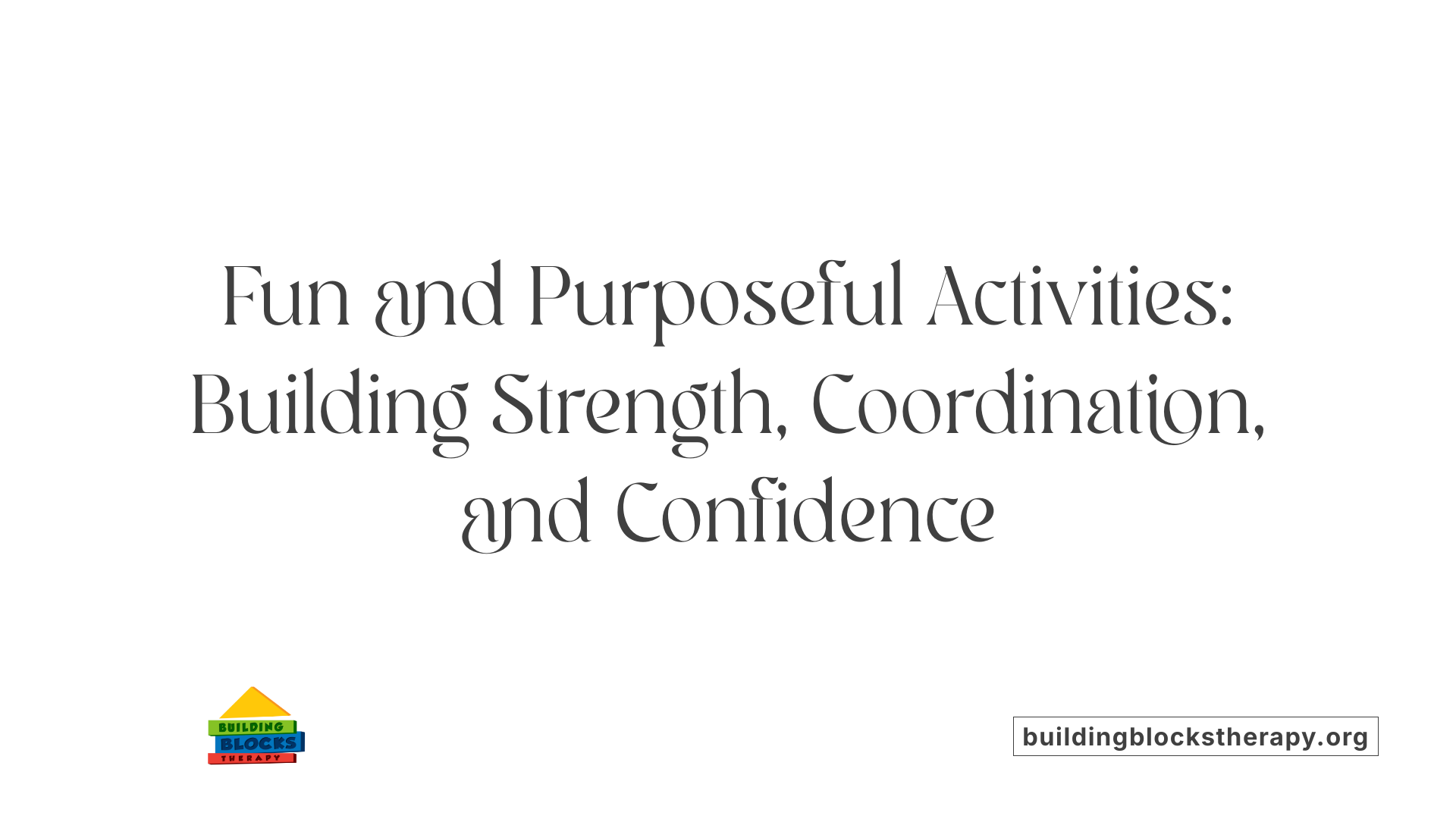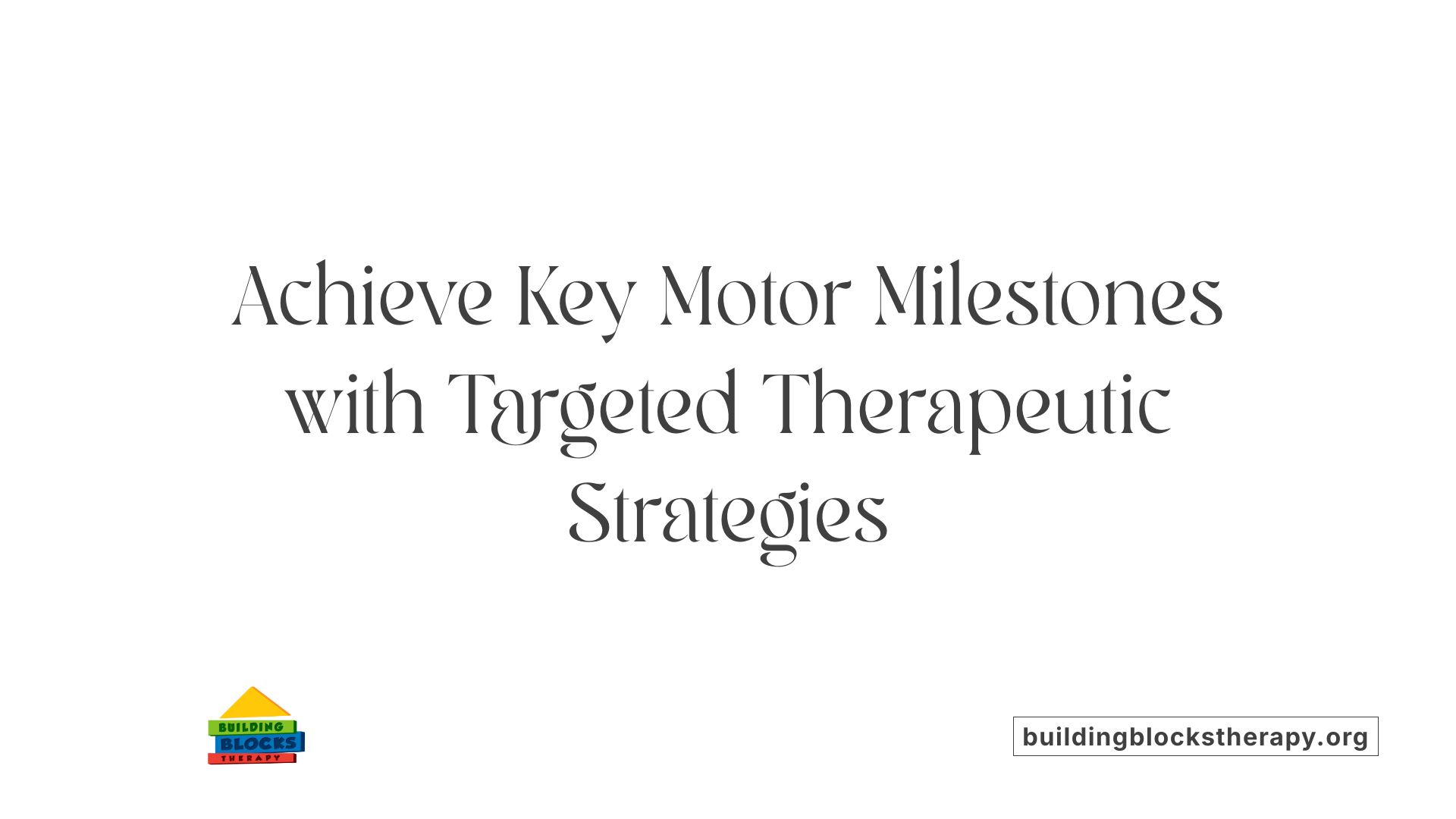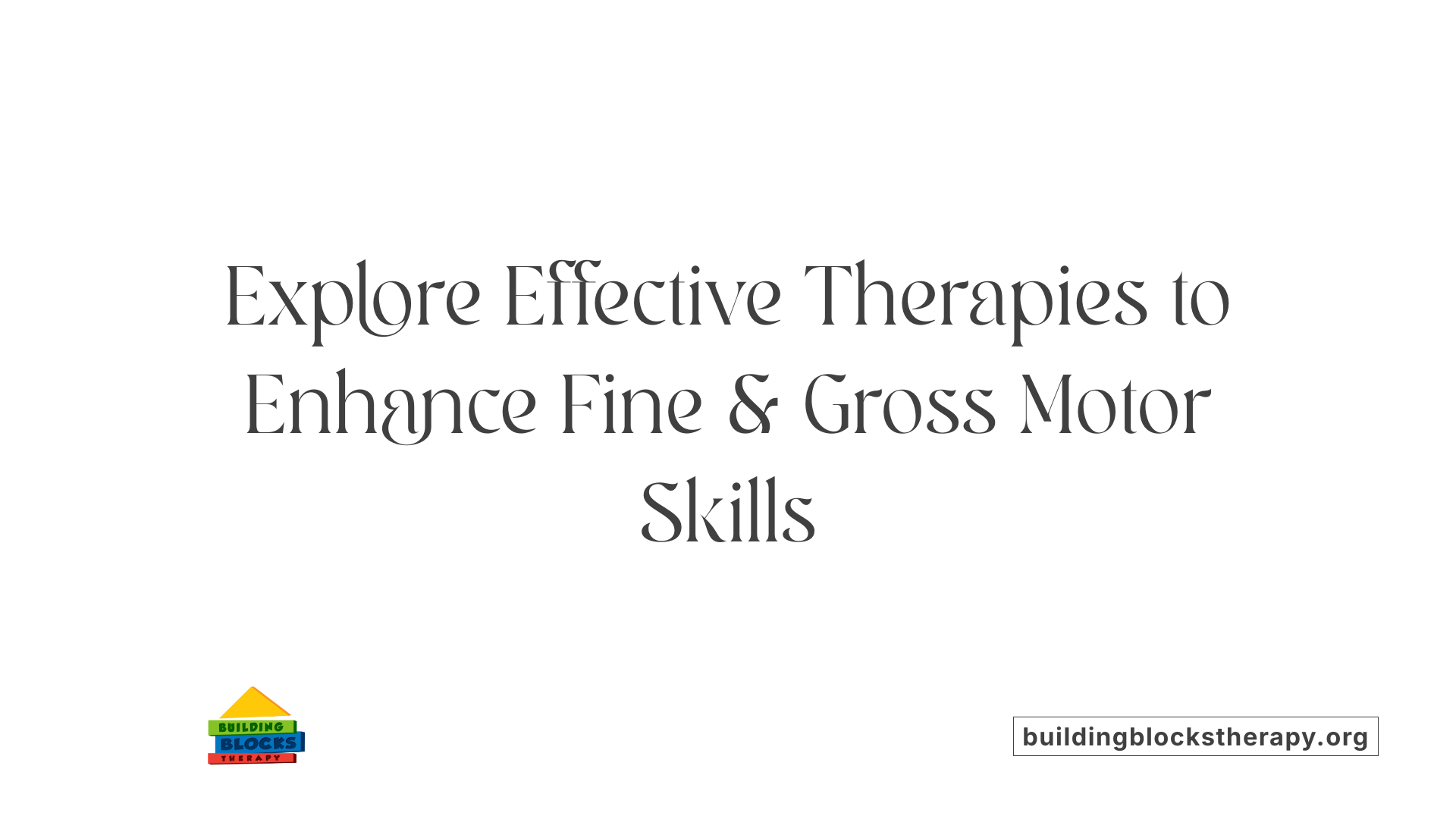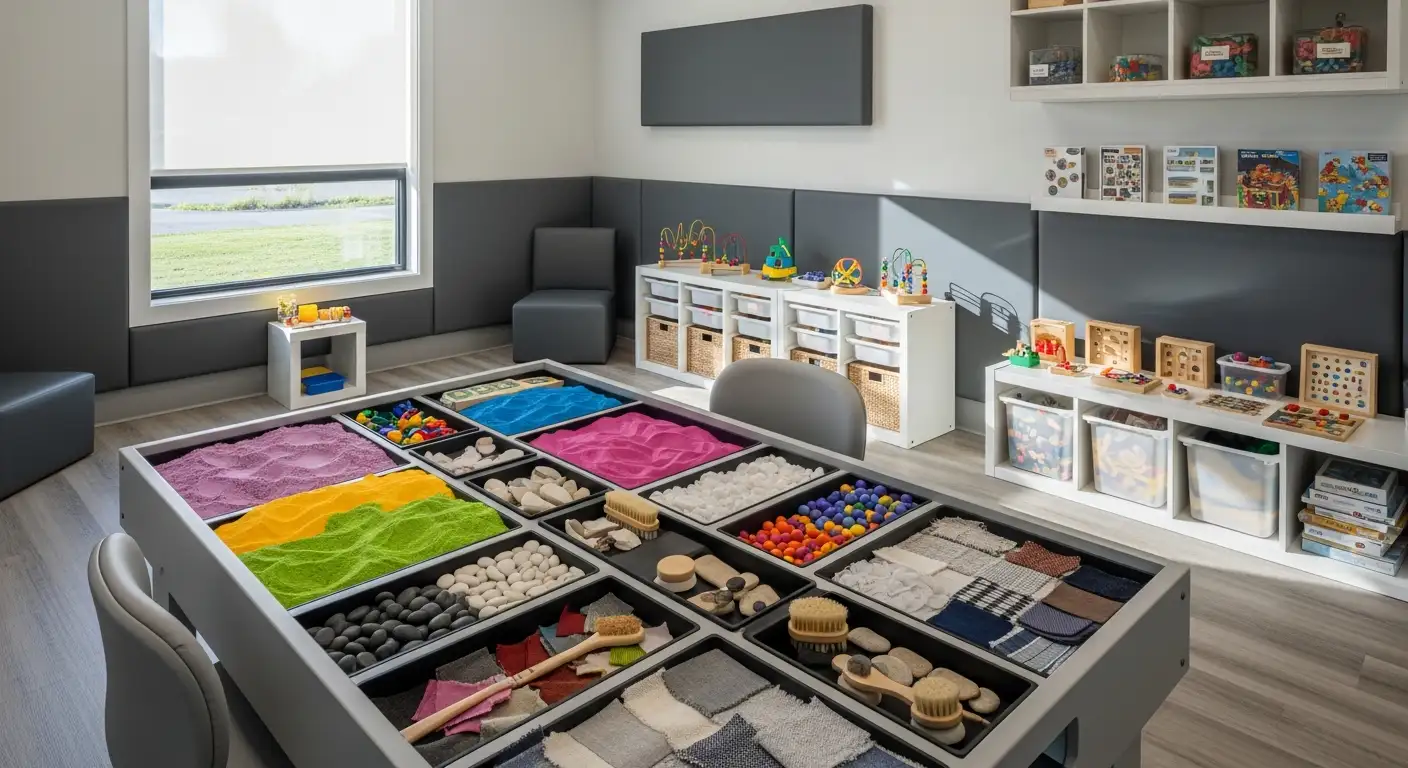Introduction to Motor Skills and Therapeutic Benefits
Development of fine and gross motor skills is essential for children's independence, academic success, and overall well-being. As children grow, early intervention and targeted therapy play a crucial role in ensuring they reach their developmental milestones. This article explores how various therapeutic approaches, especially goal-oriented play activities, enhance children's motor abilities, empower families, and support lifelong health and confidence.
The Power of Goal-Oriented Play Activities in Motor Development

How does therapy, especially goal-oriented play activities, benefit children's fine and gross motor development?
Engaging children in targeted, goal-oriented play activities serves as a highly effective approach to enhancing their motor skills. These activities are designed to be purposeful and enjoyable, encouraging children to actively participate in exercises that promote muscle use and coordination.
For gross motor skills, activities like running, jumping, balancing, and throwing help build muscle strength, improve agility, and develop overall coordination. Such exercises stimulate larger muscle groups, which are essential for movements like walking, climbing, and jumping. As children repeatedly practice these tasks, they become faster, stronger, and more confident in their physical abilities.
Fine motor development also benefits significantly from structured play such as arranging blocks, threading beads, or cutting with scissors. These activities strengthen small muscles in the hands and fingers, improve dexterity, and enhance eye–hand coordination—all crucial for tasks like writing, buttoning, or manipulating small objects.
Research shows that children participating in a 12-week program involving activities like running, balancing, throwing, and planning objects display remarkable advancements in motor skills. Assessments measuring speed, balance, arm power, jumping, and coordination demonstrate significant improvements after such targeted interventions.
Therapy, particularly goal-oriented play, supports sensory integration, motor planning, and strength development. It creates engaging, supportive environments where children can build skills in a fun manner, which boosts motivation and confidence.
Early participation in these activities encourages children to reach developmental milestones more effectively, reduces the risk of future motor delays, and improves independence in daily routines. Over time, the structured, playful nature of these interventions fosters holistic growth, preparing children for success in school, play, and other everyday activities.
In summary, goal-directed play activities are vital in promoting comprehensive motor development, helping children become more agile, strong, and coordinated—setting a strong foundation for their overall physical health and functional independence.
The Critical Role of Occupational Therapy and Alternative Approaches
What role do occupational therapy and other approaches play in improving children’s motor skills?
Occupational therapy (OT) and additional therapeutic methods are essential for helping children develop their motor skills effectively. These approaches provide customized, engaging activities tailored to each child's unique needs, focusing on both fine motor tasks like handwriting, buttoning, and dressing, and gross motor skills such as jumping, running, and balancing.
OT sessions utilize play-based strategies that incorporate sensory integration techniques—using textured materials, movement games, and heavy work activities—to make therapy enjoyable and productive. For example, therapists might help children strengthen their hand muscles through activities like squeezing putty or practicing cutting with different scissors. They might also use adaptive tools, such as special scissors or weighted vests, to support skill development.
In addition to traditional OT, other interventions include developmental approaches like DIR/Floortime, which emphasizes emotional engagement and following the child's lead in play to promote motor growth. Applied Behavior Analysis (ABA) programs use structured reinforcement strategies to teach motor skills systematically, especially beneficial for children with autism. Music therapies, such as Neurologic Music Therapy (NMT), leverage rhythm and sound to improve coordination and sensory processing.
Early diagnosis and intervention are critical. Addressing motor delays promptly during sensitive developmental periods improves outcomes and helps prevent secondary issues like low self-esteem or difficulties with school routines. With timely, targeted, and holistic support, children can achieve greater independence, confidence, and participation in daily activities.
| Approach | Focus / Techniques | Goals / Benefits |
|---|---|---|
| Occupational Therapy | Sensory integration, adaptive tools | Improve fine and gross motor skills, independence |
| Developmental (DIR/Floortime) | Play-based, relationship-centered | Enhance motor skills through emotional and sensory engagement |
| ABA Therapy | Structured, reinforcement-based learning | Systematic skill acquisition, especially for autism spectrum |
| Music Therapy (NMT) | Rhythmic and sound-based activities | Boost coordination, sensory integration, emotional connection |
Overall, combining these strategies offers a comprehensive pathway for children to develop essential motor skills. The collaborative efforts of therapists, parents, and teachers are crucial to ensuring children gain the skills necessary to thrive in daily life.
Strategies and Techniques to Promote Motor Skills Development
What techniques and strategies are used in therapy to support children's motor development?
Therapists use a wide range of methods to help children improve their motor skills, both fine and gross. Play-based activities are central, with exercises like bead stringing, which aids in hand-eye coordination and dexterity, and cutting exercises starting with simple straight lines, progressing to more complex shapes. Jumping, crawling, and obstacle courses are also incorporated to enhance gross motor strength, balance, and coordination.
Sensory integration is another vital component. Techniques such as swinging on a vestibular swing, using textured materials for tactile stimulation, and engaging in movements like rocking or deep pressure therapy help children organize sensory inputs better. These methods regulate sensory processing, which can improve movement control and reduce sensory overload.
Relationship-based interventions like DIR/Floortime emphasize engaging play, following the child's lead, and building emotional connections. This approach incorporates sensory-rich play and motor activities, encouraging children to develop coordination and strength within a supportive, interactive context.
Structured and evidence-based treatments, including occupational therapy, tailor exercises and tools to each child's needs. This might involve specific handwriting programs, adaptive tools such as specialized scissors, or targeted strength exercises like squeezing therapy putty.
In addition, caregiver involvement is encouraged so families can practice activities at home, reinforcing progress. Approaches grounded in research, such as neurodevelopmental techniques and programs for children with autism or developmental coordination disorder, ensure interventions are effective and targeted.
By combining play, sensory activities, relationship-based strategies, and structured programs, therapists create a comprehensive plan that addresses each child's unique motor development challenges, maximizing their growth and independence.
Developmental Milestones and Progress through Therapeutic Interventions

What are some developmental milestones achieved through motor skills therapy?
Motor skills therapy plays a crucial role in helping children reach important developmental milestones that are foundational for their overall growth and independence. Early milestones include sitting independently, crawling, standing, and walking. These skills typically emerge during the first few years of life and are essential for exploring the environment and developing body awareness.
As children grow, therapy interventions also support more advanced activities. These include climbing stairs, jumping, riding tricycles, and performing complex movements like skipping and skating. Swimming and riding bicycles are later milestones that demonstrate coordination, strength, and confidence.
Therapeutic programs focus on enhancing several physical abilities such as:
- Strength
- Balance
- Coordination
- Motor planning
- Body awareness
By improving these areas, therapy helps children explore their surroundings more confidently, participate actively in play, and develop social skills.
Furthermore, reaching these milestones contributes to a child's sense of competence and independence. Children gain the ability to navigate their environment better, which encourage them to engage in new activities and challenges.
Supportive role of motor skills therapy in reaching milestones
Therapists design targeted exercises and activities that promote the development of gross motor skills. These include obstacle courses, balance beams, jumping activities, and strength-building exercises.
The goal is to improve core strength, postural control, and overall movement efficiency. Such improvements enable children to perform daily activities more easily and safely.
Enhancement of strength, balance, coordination, and motor planning
Motor skills therapy is not just about achieving milestones but also about refining movement quality. It aims to develop:
- Muscular strength to support prolonged activities
- Balance to maintain stability during dynamic movements
- Coordination between different body parts for fluid motion
- Motor planning abilities to execute sequences of movements effectively
These skills are vital for both basic tasks like dressing and feeding and more complex activities such as sports and recreational pursuits. As children progress through therapy, they build resilience and confidence, eventually mastering skills that enable them to participate fully in school and social life.
Types of Therapeutic Interventions for Motor Skills Enhancement

What types of therapy are available for enhancing fine and gross motor skills in children?
Children’s motor skill development can be supported through various therapeutic approaches, tailored to their specific needs and challenges.
Occupational therapy (OT) plays a significant role in improving fine motor skills such as handwriting, buttoning, and using utensils. OTs utilize activities like bead stringing, using adaptive tools, sensory feedback techniques, and playful exercises to promote hand strength, coordination, and dexterity. These therapies are often integrated into daily routines, helping children gain independence in tasks like dressing and self-care.
Physical therapy (PT) complements OT by focusing on gross motor skills like walking, jumping, and climbing. PT sessions involve goal-oriented activities such as obstacle courses, running, balancing on beams, and jumping jacks. These activities aim to enhance muscle strength, coordination, balance, and motor planning necessary for everyday movements.
Developmental therapy combines various approaches, including play-based exercises and targeted activities to stimulate overall motor development. It often incorporates techniques from OT and PT to address delays or difficulties in motor milestones.
Additionally, alternative therapies like aquatic therapy utilize water-based exercises to develop muscular strength and coordination with reduced joint stress. Such therapy is especially beneficial for children with physical disabilities or those who need a gentle environment to encourage movement.
Sports therapy and specialized physical activities also support gross motor training. These include structured sports, rhythmic activities, and exercises like catching, throwing, and climbing, which improve overall physical fitness and coordination.
Why are early assessment and personalized therapy plans important?
Early evaluation by occupational and physical therapists helps identify delays or challenges in motor skills, allowing for tailored therapy strategies. Developing personalized plans ensures targeted intervention that addresses specific weaknesses, optimizes progress, and supports skills like handwriting, self-care, and sports participation.
How does family involvement enhance therapy outcomes?
Families and caregivers are vital in reinforcing learned skills through daily practice and encouragement. Participating in therapy sessions, engaging in home activities, and supporting consistent routines foster better progress and boost children’s confidence in their abilities.
By combining professional therapy with active family participation, children can achieve meaningful improvements in both fine and gross motor skills, promoting overall independence and participation in daily life.
Impact of Therapeutic Activities on Motor Skills and Overall Development

How do therapeutic exercises and activities impact children's motor skills?
Engaging children in therapeutic exercises plays a vital role in enhancing their motor development. Structured physical activities such as jumping, obstacle courses, and swimming are particularly effective for building both gross and fine motor abilities. These activities help children improve muscle strength, coordination, balance, and movement planning.
Research indicates that early, consistent intervention yields significant gains in motor skills. For example, children with developmental delays or conditions like Down syndrome often see notable improvements when involved in regular therapy programs. Earlier therapy initiation is associated with better long-term outcomes, promoting independence and participation in daily routines.
Innovative approaches like exergaming—video games that require physical movement—also boost motor performance. These engaging activities develop locomotor skills, hand-eye coordination, and balance, making therapy enjoyable and motivating for children.
In addition to traditional exercises, functional training programs focus on fundamental movements such as running, jumping, and balancing. These are crucial for overall motor proficiency. Aerobic exercises, including treadmill training, support gait development and endurance, especially beneficial for children facing mobility challenges.
Studies involving children aged 6-12 years and those with ADHD demonstrate that targeted physical activities can enhance motor control, improve confidence, and foster a positive attitude towards movement. This, in turn, boosts self-esteem and encourages active participation in sports, play, and school activities.
Overall, integrating structured therapeutic activities into children's routines—whether through physical therapy, play, or innovative methods—supports comprehensive motor skill development. Consistent, engaging exercises help children attain their developmental milestones, leading to better physical health, increased confidence, and greater independence.
Importance of Continued Therapy and Parental Involvement
Ongoing assessment and goal setting are crucial for tracking progress and adjusting intervention strategies to meet each child's evolving needs. Professionals like occupational and physical therapists regularly evaluate motor skills to identify new challenges and celebrate achievements, ensuring that therapy remains relevant and effective.
Parents play a vital role in this developmental journey. Their participation in practice routines at home helps reinforce skills learned during therapy sessions. Simple activities like threading beads, practicing buttoning, or engaging in obstacle courses can significantly enhance motor development and confidence.
In-home therapy offers notable benefits, such as reducing stress for children, providing personalized attention, and involving family members directly in the therapy process. Having a therapist work within familiar environments also helps generalize skills to daily routines, promoting consistency and faster progress.
Long-term support through continuous therapy fosters sustained development, encouraging children to reach their full potential. It not only improves motor abilities but also boosts confidence, independence, and participation in everyday activities. This ongoing effort ensures children develop the strength, coordination, and motor planning skills necessary for lifelong success.
Can physical therapy help improve children’s fine and gross motor skills?
Yes, physical therapy can significantly help improve children's fine and gross motor skills. Through specialized exercises and activities tailored to each child's developmental level, therapists can promote strength, coordination, balance, and motor planning. For fine motor skills, activities such as coloring, cutting, and playing with small objects enhance hand strength and dexterity. For gross motor skills, exercises like crawling, walking, jumping, and balancing help develop larger muscle groups and coordination. Early intervention with a licensed physical therapist supports children in achieving developmental milestones and improving their overall motor abilities.
Concluding Insights: Building a Foundation for Lifelong Motor Skills
Motor skills are essential in early childhood development as they form the basis for a child's ability to explore and understand their environment. Developing both fine and gross motor abilities allows children to perform everyday tasks like writing, dressing, running, and jumping with independence and confidence.
Early intervention through targeted therapies, such as occupational therapy, plays a crucial role in addressing motor skill challenges. These programs are tailored to each child's specific needs, focusing on strengthening muscles, improving coordination, and enhancing motor planning.
Family involvement amplifies the benefits of therapy. When parents and caregivers actively participate in practice activities and reinforce skills at home, children are more likely to make steady progress and feel supported.
Engaging children in goal-oriented play—whether through obstacle courses, arts and crafts, or sports—makes therapy enjoyable and effective. These playful activities not only develop motor skills but also promote social interaction, emotional well-being, and cognitive development.
Overall, a holistic approach that combines early intervention, family support, and consistent practice helps children build a strong motor foundation. This foundation supports their confidence, participation in daily routines, and enjoyment of active living, fostering a healthier, more independent future.
Fostering Growth Through Therapeutic Engagement
In conclusion, therapy plays an essential role in nurturing children's motor development, ensuring they reach key milestones with confidence and independence. Early, personalized intervention combined with family participation can lead to significant improvements in fine and gross motor skills, which are foundational for overall development, academic achievement, and self-esteem. By leveraging play-based, sensory-rich, and physically engaging activities, therapists help children develop coordination, strength, and confidence. Promoting ongoing support and involvement from parents and caregivers not only accelerates progress but also enriches a child's ability to participate actively in everyday life while building a lifelong foundation for health and success.
References
- Improving Motor Skills in Early Childhood through Goal-Oriented ...
- How occupational therapists help kids who struggle with motor skills
- Pediatric Therapies for Fine and Gross Motor Skill Growth - Coral Care
- Occupational Therapy Techniques for Improving Fine Motor Skills in ...
- Fine Motor Skills Therapy - Care Options for Kids
- Therapy for Older Children with Developmental Delays
- Gross Motor Activities - Kid Sense Child Development
- Motor Milestones Therapy | Lurie Children's
- 35 Fine Motor Activities: Therapists' Ultimate List - NAPA Center






